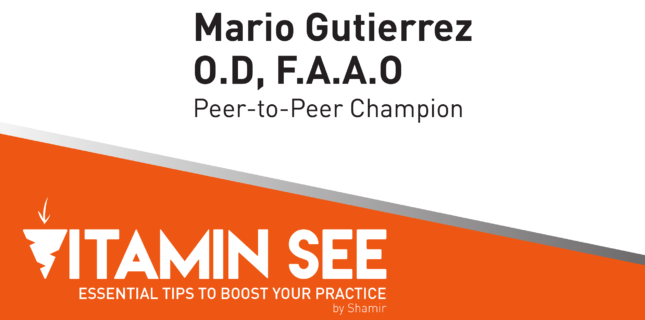
Staff Training Strategies

Mario Gutierrez O.D., F.A.A.O.
I’m Mario Gutierrez, O.D, F.A.A.O, and I founded the San Antonio Vision Source Network in 1991. Besides practicing 40 hours a week at Vision Source Alamo Heights in Texas, I’m the administrator for Vision Source San Antonio, on the Vision Source Advisory Board, and an adjunct professional at the University of Houston College of Optometry and Rosenberg School of Optometry. And recently, I was appointed by the governor as Chairman of the Texas Optometry Board.
CRITICAL COMPONENT
As I’ve continued to take on new responsibilities, it’s become increasingly clear that one of the most critical components of any practice—and certainly mine—is staff education and training. It has, in fact, become ever more important as we’ve grown from a small practice to one with 3 doctors and 24 employees.
Back 34 years ago, doctors did most of the initial testing. But, as things changed and we moved from a cash basis to insurance-based patient care, reimbursements were reduced, and we had to learn to practice smarter.
DIFFERENT STROKES
One Challenge we’ve encounter? Everybody learns differently, so the key is finding how to teach all individuals so they can learn tasks and systems. It is important for the doctors and managers to understand that there is a difference from lecture style and one-size-fits-all staff training to helping the individual staff member really learn. Learning and getting “trained” are not the same.
The approach we’ve taken is to have the vendor’s trainer meet with the doctors and staff together to talk about a new product.
We’ll reinforce what the trainer from the company discussed, and then determine who gets it and who doesn’t. Some people may have to do it over and over because that’s how they learn. On the other hand, other employees hear it and they’ve got it. In other words, some people just need to see it or hear it, while others need to do it.
WHAT + WHO
The bottom line is you have to figure out what learning strategy works for whom. You can start to learn that at hiring. For example, when interviewing, I ask, “How do you learn best?” People are usually upfront and say, for example, “I learn best by doing it.” So, for them we practice a training task/procedure a bunch of times until they get it. Somebody else will just see it and be able to do it right away.
OPTICAL TRAINING
In the optical, our goal is to train so that they can get their certification. We encourage our staff to do this, and we give them a financial incentive if they are certified. That ongoing training helps all of us—by refreshing our skills and helping to keep up-to-speed with the changes that are occurring.
OUTSIDE RESOURCES
We try to partner with our frame vendors and our labs—and I’ll tell you our best lens rep is from Shamir—and we ask him to come in maybe every six months. It’s not a dog and pony. What we ask him isn’t just how to problem solve, but more importantly, how to problem prevent. Great customer service starts with problem prevention! We also ask him the best way to educate patients about his company’s products—in other words, why they should buy lenses from us and why should those lenses be Shamir.
INTERNAL EDUCATION
We also have ongoing staff education. Once we got to a certain size, by necessity, we began meeting by various departments. And, we still try to meet once a month by department. We’ll have a front office meeting, which will include the billing department. Then we will have an optical department meeting, which includes our lab, opticians, and doctors. And then there will be a clinic meeting, with our doctors and technicians, along with our fourth-year optometry students. Our managers attend all department meetings.
MORNING HUDDLE
For optometrists whose practices are smaller, I think it’s important not just to meet the way we do, but also to have a daily huddle. That used to be so effective, where I could call everybody into my office each day before we started.
We’d go over what we’d be working on. For example, I might say, “Today, when we verify insurance, we’re going to ask patients if there are any other family members who might need their eyes examined this week. We can look at the record and mention to the patient on the phone, “I see Betsy is due for an exam. Would you like to schedule her appointment next to yours?”
It’s that sort of thing that in a small office is really cool—but it’s not just smaller offices. I think department huddles are great for any size practice. The thing I did wrong, is assuming because you think a certain way, your staff does too. Well, they don’t, so you have to be very specific. And that’s well accomplished by a daily huddle and, of course, ongoing staff education.
One of my colleagues used to ask why I trained people if they were just going to get trained and leave. I always answered the same way: “Yes, but what if they stay?”
Comments are closed.







